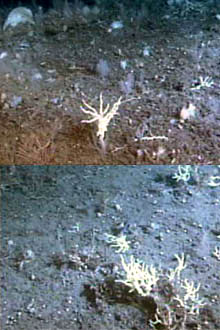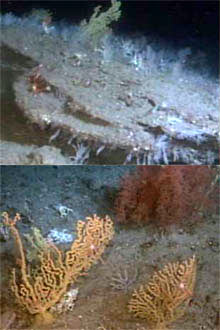
Examples of bottom habitat observed during the morning dive at Stetson Banks. Notice the small clumps of Lophelia pertusa and several small soft corals in both photographs. Click image for larger view and image credit.
Double Take at Stetson Banks
October 28, 2005
Dr. Martha Nizinski
Co-PI, NOAA, National Marine Fisheries Service National Systematics Laboratory
Andrea Quattrini
Fisheries Research Technician
Center for Marine Science, University of North Carolina Wilmington
Stetson Banks is one of our primary targets. This site was first explored and described by Thomas Stetson and colleagues in 1962. There have been many technological advances since then providing better tools to help us explore and characterize this habitat and document the organisms that live there. The Stetson site provides an interesting comparison to our other study sites where the faunal composition and the overall habitat characteristics are quite different. For example, the extensive Lophelia reef systems we observe off North Carolina are not present here, nor are the high sediment, low profile habitats we observed at Savannah Banks.
Our study sites are not discrete locations, but more of a localized region. Just like cities are represented as points on a map but encompass much larger areas than the city center, so are our study sites. Our study sites, however, represent only point estimates of biodiversity along an expansive continental slope. Stetson reported over 200 distinct features within this study area and there are probably many more. Thus, we need to make multiple dives at each study site to document the diverse habitat and organisms in this region. The dives today at Stetson are a good example of why one dive just isn't enough. The target locations for the dive sites today were only about 14 miles (approximately 31 km) apart but what was observed on each dive was different.
Martha made the morning dive. Our sonar survey from the night before showed a system of ridges and valleys. Bottom depth was 2000 feet (610 m) at the start of the dive. Our dive track took us up and over several ridges. The habitat was surprisingly similar throughout the entire dive. The bottom was covered with coarse sediment and coral rubble. We observed small, low profile, discrete bunches of Lophelia and another hard coral, Enallopsammia , dispersed over the bottom. Additionally, we observed high abundances of several species of soft corals (octocorals) and sponges scattered over the bottom. The abundance of coral varied, depending on the area we surveyed. Coral abundance was often higher on the tops of ridges and on the up-current side of the ridge. It was quite surprising that we saw so few crustaceans and fishes. Only one individual of the squat lobster ( Eumunida picta ), abundant off North Carolina, was observed. The fish fauna was dominated by two species, with only a single individual of four additional species observed. The diversity was lower than what we have seen at other sites, but the majority of animals we did observe were very abundant.

Examples of bottom habitat observed during the afternoon dive at Stetson Banks. The top photograph is a rock outcrop with attached soft corals. The bottom photograph shows a black coral (to the top right) and soft corals. Click image for larger view and image credit.
Andrea made the afternoon dive. The submersible landed on top of a ridge in 2139 feet (655 m). A strong current (>1knot) prevented the sub from transecting directly to the targeted location, a feature located ~1000 feet (328 m) away that we mapped in 2003. Because of the strong current, we mainly moved down slope and near the bases of ridges; however, at times we were able to move up slope. We were able to make some headway, and by the end of the dive, we had documented over 600 feet (183 m) of habitat. Habitat was similar throughout the dive. Near and on tops of ridges, there were small rock outcrops with < 3 feet (< 1 m) vertical profile. These outcrops were covered with coarse sediment and coral rubble. Sediment covered rubble also was found on the bottom near and off the bases of the ridges. Attached fauna were abundant throughout the dive and species observed were similar to those on Martha's dive. We, however, observed a greater abundance and diversity of antipatharians (black corals), soft corals (octocorals), and fishes. At least seven fish species were observed during this dive, including Laemonema melanurum, Nezumia sp., and Polyprion americanus (wreckfish) . Crustaceans were not very abundant on this dive compared with other study sites, but more were observed in comparison to Martha's dive.
Today's very productive observations and collections make it clear to us that we are attempting to characterize a huge, diverse region of deep-sea coral habitat, one dive at a time. Each dive (or additional sample) represents another small dot on the map from North Carolina to Florida at depths of over 300-900 m. Our progress has been steady, and we continue to expand our knowledge of the region and interrelationships among fauna, habitat, and location.
Sign up for the Ocean Explorer E-mail Update List.

























